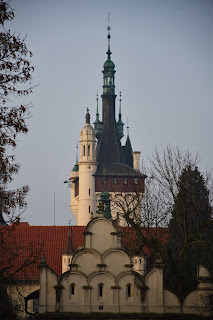Cannes and the Lérins
This morning, we left Nice for another day trip, this time to Cannes. The train took some 40 minutes and dropped us off in the very centre of town. Instead of strolling around, however, we made a beeline to the esplanade and followed it to the port.
While most people
alive today know Cannes for its film festival, the roots of its cultural cachet
go much deeper. Only a quarter of an hour south of Cannes lie two islands,
whose defensibility ensured their primacy over the area in ancient times. The
smaller of the islands, Saint-Honorat, has been home to a monastic community
since the early fifth century. The only lull in its activity occurred around
the times of the French Revolution, but the monastery was re-established within
a century.
The larger island is
called Sainte-Marguerite. The name rang a bell when I was doing my research for
this trip and with good reason: its fort is where the famous man in the iron
mask was once held. As we learned during our visit, however, this mysterious
inmate was far from the only prisoner to be kept at the fortress. Over the
years, the island imprisoned many live reminders of France’s sordid dealings:
protestant preachers arrested after Louis XIV’s Edict of Fontainebleau,
Algerian captives taken in France’s colonisation of the country, and various
political prisoners. In 1816, Napoleon sent his Mameluke guard to the island to
keep them from being massacred by the population of Marseille.
The boats for
Saint-Honorat and Sainte-Marguerite departed every hour. We did not realise
this would be the case but were thankful for it, as departures are less
frequent during winter. We bought our tickets just above the quay and shared
the boat with a massive group of senior pilgrims. Fortunately, their need to
stick together meant that we were able to outrun them on our way to the
monastery and make a quick tour of the island’s chapels before the horde
descended. We returned to the shore before twelve, which was just in time to
catch the next boat to Saint Marguerite. After touring the fort, we wandered
around the western end of the island for a while, though we could not figure
out how to get close to the island lake.
We returned to Cannes
a little before three o’clock and felt famished. Back on the boat, we had
already determined which street would be the destination of our culinary
pilgrimage, and it was not difficult to find one with relatively acceptable
prices and a palatable selection. The mussels I ordered, however, were so tiny
that I struggled for almost an hour to get through the whole meal, handling
shells as though I were a machine at a munitions factory.
We spent the rest of the afternoon in Cannes, clambering up to the Church of Our Lady of Hope and then down again through picturesque old streets to the main promenade. Since there was no way we could leave out such an attraction on a visit to Cannes, we stopped by the Palace of Festivals and Congresses, where the iconic red-carpet pictures of celebrities are traditionally taken. One interesting fact about the film festival is that is started because of Benito Mussolini. Incensed at the victory of propagandistic Italian and German films at the festival in Venice, the American, British, and French juries withdrew, with France deciding to set up a film festival of its own. However, since the first get-together was interrupted by Hitler’s invasion of Poland, the first proper film festival in Cannes was held in 1946.































































Comments
Post a Comment